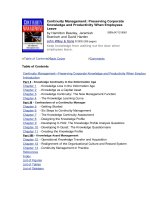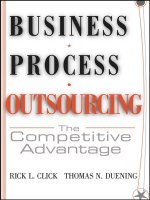John wiley sons incorporate your business when to do it and how oct 2004 tlf
Bạn đang xem bản rút gọn của tài liệu. Xem và tải ngay bản đầy đủ của tài liệu tại đây (12.93 MB, 256 trang )
Incorporate
Your Business
Incorporate
Your Business
When To Do It and How
ROBERT A. COOKE
John Wiley & Sons, Inc.
This book is printed on acid-free paper. ∞
Copyright © 2005 by Robert A. Cooke. All rights reserved.
Published by John Wiley & Sons, Inc., Hoboken, New Jersey.
Published simultaneously in Canada.
No part of this publication may be reproduced, stored in a retrieval system, or transmitted in any form or
by any means, electronic, mechanical, photocopying, recording, scanning, or otherwise, except as permitted under Section 107 or 108 of the 1976 United States Copyright Act, without either the prior written permission of the Publisher, or authorization through payment of the appropriate per-copy fee to the
Copyright Clearance Center, Inc., 222 Rosewood Drive, Danvers, MA 01923, (978) 750-8400, fax (978)
646-8600, or on the Web at www.copyright.com. Requests to the Publisher for permission should be addressed to the Permissions Department, John Wiley & Sons, Inc., 111 River Street, Hoboken, NJ 07030,
(201) 748-6011, fax (978) 646-8600.
Limit of Liability/Disclaimer of Warranty: While the publisher and author have used their best efforts in
preparing this book, they make no representations or warranties with respect to the accuracy or completeness of the contents of this book and specifically disclaim any implied warranties of merchantability or fitness for a particular purpose. No warranty may be created or extended by sales representatives or written
sales materials. The advice and strategies contained herein may not be suitable for your situation. The publisher is not engaged in rendering professional services, and you should consult a professional where appropriate. Neither the publisher nor author shall be liable for any loss of profit or any other commercial
damages, including but not limited to special, incidental, consequential, or other damages.
For general information on our other products and services please contact our Customer Care Department
within the United States at (800) 762-2974, outside the United States at (317) 572-3993, or fax (317)
572-4002.
Wiley also publishes its books in a variety of electronic formats. Some content that appears in print may
not be available in electronic books. For more information about Wiley products, visit our web site at
www.Wiley.com.
Library of Congress Cataloging-in-Publication Data:
Cooke, Robert A., 1931–
Incorporate your business : when to do it and how / Robert A. Cooke.
p. cm.
Includes index.
ISBN 0-471-66952-0 (pbk.)
1. Incorporation—United States—Popular works. 2. Corporation law—United
States—Popular works. I. Title.
KF1420.Z9C65 2004
346.73′06622—dc22
2004042247
Printed in the United States of America.
10 9 8 7 6 5 4 3 2 1
CONTENTS
CHAPTER 1
CHAPTER 2
Why Should I Incorporate My Business?
What a Corporation Is, and What It Is Not
Who Starts and Who Owns a Corporation?
Reasons to Incorporate Your Business
Limiting Your Liability for Business Debts
Liability of Stockholders Who Are Also
Employees of Small Corporations
Save Payroll Cash by Incorporating
Tax Savings
Prestige of a Corporation
Ease of Transferring Ownership
Reasons Not to Incorporate Your Business
Corporations and Other Business Forms Are
Too Complicated
Corporations Cost Too Much to Set Up
and Operate
My Business Is Too Small to Incorporate
A Corporate Form Does Not Entirely
Protect Professionals
How Incorporating Can Result In Tax Savings
Tax Savings In a Corporation? Maybe
The Organization of this Chapter
An Example of Tax Saving from a Corporation
Some Background, Concepts, and Explanations
How Your Business Tax Picture Changes When You
Incorporate
How a Sole Proprietorship Is Taxed
How a Corporation Is Taxed
Double Taxation of Corporate Profits
How to Cope with Double Taxation of
Your Corporation
v
1
3
4
5
5
7
9
10
10
10
11
11
12
13
13
15
15
16
16
17
18
18
21
23
24
CONTENTS
Pay Dividends Between May 6, 2003 and
December 31, 2008
Keep Earnings in the Corporation
Pay Salaries to Stockholders/Employees
The IRS Position on Salary Levels for
Stockholder/Employees
Pay Interest to Stockholders
Alternative Minimum Tax on Corporations
What If the Corporation Has a Net Loss Instead
of Net Taxable Income?
S Corporations
How Stockholders Take Profits out of an
S Corporation
The Disadvantages of an S Corporation
Type of Stockholders
Number of Stockholders
Use of the Corporation’s Loss, If It Has a
Bad Year
Flow-through of Certain Tax Attributes to
the Stockholder
S Corporations Are Limited to One Class of Stock
When to Use an S Corporation
CHAPTER 3
CHAPTER 4
24
24
25
26
28
29
30
31
32
33
33
34
34
35
36
37
The Alternatives to Forming a Corporation
Sole Proprietorship
General Partnership
Limited Partnership
Limited Liability Company (LLC)
Other Entities With Limited Liability of the Owners
Passive Losses
Which Business Form Best Attracts Investors to
Your Enterprise?
41
41
42
43
43
45
46
How to Structure a Corporation
The Basic Corporation
Assets, Liabilities, and Equity
51
52
52
vi
47
Contents
How to Invest In Your Corporation
Debt versus Equity
The IRS Position on Debt versus Equity
How to Invest In Your S Corporation
Keep Control of Your Corporation If Possible
CHAPTER 5
Planning Your Corporation
Do-It-Yourself Incorporation
Using Professionals
Choosing an Attorney
Choosing an Accountant
Planning the Specifics of Your Corporation
Decide on the Size of the Initial Investment in
the Corporation
Size Your Investment to Qualify for Treatment
as a Small-business Corporation
Who Will Be the Owners (Stockholders) of
Your New Corporation?
Determine How Many Shares of Stock Will Be
Authorized and Issued
Determine What the Price per Share of Stock
Will Be
Determine Who Will Be the Directors and
Officers, and Assign Duties
Prepare a Pre-incorporation Agreement
Determine Who Will Be the Incorporator(s)
Select a Resident Agent for Your Corporation
Have All Prospective Stockholders Sign a
Stock Subscription
Determine the State in Which You
Will Incorporate
Choose a Name for Your Corporation
Determine If You Can Use a
Simplified Procedure
Prepare a Pre-incorporation Agreement
Prepare a Stockholders’ Agreement
vii
54
58
60
61
62
65
65
66
67
67
68
68
70
71
72
74
77
79
79
80
81
82
85
88
89
90
CONTENTS
CHAPTER 6
Steps to Create and Run Your Corporation
Steps to Forming Your Corporation
Initial Action the Incorporator(s) Should Take
Hold Organizational Meetings
Organizational Meeting of the Stockholders
Organizational Meeting of the Board of Directors
Register Your Corporation with the Internal Revenue
Service (IRS)
Register Your Corporation with Your State’s
(and Any Foreign State’s) Tax Authorities
Elect S Status for Your Corporation If That Is
Your Decision
Pay Particular Attention to the Initial Corporate
Income Tax Return
Steps to Keep Your Corporation Alive
Hold the Annual Stockholders Meeting Every Year
Hold an Annual Board of Directors Meeting
Every Year
Special Meetings of the Board of Directors
(or of Stockholders If There Is No Board
of Directors)
Live Your Corporate Life as If You Meant It
Nonprofit Charitable Organizations
93
93
93
99
100
100
100
101
102
102
103
104
104
105
105
106
APPENDIX A
Useful Forms
107
APPENDIX B
Useful Addresses
213
APPENDIX C
Short Course in Corporate Finance Terms
227
APPENDIX D
Glossary
231
239
INDEX
viii
Incorporate
Your Business
CHAPTER 1
Why Should I
Incorporate My Business?
T
he short answer is: It depends on
circumstances. Here’s one in which the corporation form of doing business helped cut the tax bite.
Many entrepreneurs start their businesses by sliding into them. Paul did
that. Three years ago, he started keeping a few plumbing tools and fittings
in the back of his minivan, from which he did plumbing repairs for
friends and neighbors on weekends. His reputation for quality work
spread, so he was soon able to chuck his day job. (It helped that his wife,
Yvonne, pulled down $100,000 per year as an advertising rep.) Life was
simple then, for he just drove to customers’ homes, made plumbing repairs, wrote up bills, and collected his money. Because he took care of his
customers (and even responded to emergencies at 3 A.M.), his business
grew so that he had to hire two more plumbers, two helpers, and buy three
trucks for the crews. Along with the increasing business and higher profits
came various hassles, such as license requirements in surrounding towns,
1
I N C O R P O R AT E YO U R B U S I N E S S
satisfying tax collectors and other negative manifestations of our complex
society, and hiring an accountant to keep track of his expanding empire.
“You probably could save some taxes by incorporating,” said Amos, his
accountant, as he handed Paul his tax return on April 15.
“Later,” said Paul. “It sounds like more hassle, and more hassle is what I
don’t need.”
Then in the fall of that year, Paul ran into an unfortunate situation with a
customer. One of his recently hired plumbers did not stick around and
check his work as he should have. The consequence was that the leak in
the bathroom, which was to be repaired, apparently was not. The resulting
trickle of water soaked the carpet in the hallway, requiring that it be replaced at a cost of $500. Paul paid that out of his pocket, as it was below
the deductible amount on his liability insurance policy.
Then, a few months later, Paul received a letter from an attorney representing this customer. She was claiming that she had slipped on the wet
carpet before it was replaced and suffered extensive injuries. She was
seeking $10 million from Paul.
Fortunately, the company that insured Paul was able to settle the case for
$1,000, but in the process, Paul spent many sleepless nights. Again, he
heard the same thing from Larry, his lawyer, that he had heard from his
accountant: “You should consider incorporating.”
“What if that customer had prevailed and you had found yourself facing a
judgment for $10 million?” Larry asked. “Your liability insurance policy
2
Why Should I Incorporate My Business?
covers only $1 million. You could lose not only your trucks and other business property, but much of your personal assets, such as investment accounts, your boat, and other items. I can’t guarantee it, but if your plumbing
business did operate as a corporation, it’s very likely that you would be able
to keep your personal assets, although the business assets would be gone.”
Paul listened to that advice with increasing interest but still took no action.
We will come back to Paul and his plumbing business later, after we have
discussed the points that his story illustrates thus far.
What a Corporation Is and What It Is Not
Essentially, a corporation is created as a separate entity by a government,
such as state, federal, and most foreign governments. Corporations can be
formed for a variety of purposes, the most common of which is conducting a profit-making business. They can also be formed as vehicles for
conducting nonprofit activities such as charitable organizations, social
clubs, political activities, and so on. For the most part, this book is devoted to a discussion of corporations that are in business to earn a profit
for their owners, but nonprofit charitable corporations are covered briefly
in Chapter 6. Almost all of these corporations are created by one of the 50
states, the District of Columbia, Puerto Rico, the Virgin Islands, or Guam.
Most foreign governments also provide for the formation of corporations.
If you would like a more formal definition of a corporation, here is one:
CORPORATION A fictitious legal entity/person which has rights and
duties independent of the rights and duties of real persons and which is
legally authorized to act in its own name through duly appointed
3
I N C O R P O R AT E YO U R B U S I N E S S
agents. It is owned by shareholders. Usually created under the authority
of state law (Bouvier’s Law Dictionary 1865).
For many of us, the term corporation conjures up images of behemoths
such as Microsoft, Wal-Mart, and General Motors. But those corporations
have not always been the organizations they are today with thousands of
shareholders. The first two started as enterprises owned by one or two
people and the third one is a combination of several small companies
started in garages by one or two successful dreamers.
Notice that a corporation does not exist just because one or a few entrepreneurs hang out a shingle with “Inc.” after the name of the business. A
corporation exists only by action of the state or other governments just
mentioned, as well as the federal government for certain quasi-government purposes.
Who Starts and Who Owns a Corporation?
Corporations come into being because one or more individuals, called incorporators, request a state to form a corporation. (The detailed procedure is described in Chapter 6.) The for-profit corporations are owned by
stockholders, who may or may not be the same individuals as the incorporators. (The term stockholders includes not only individuals but also
entities such as other corporations, partnerships, and limited liability
companies.) While stockholders share in the hoped-for profits generated
by the corporation, nonprofit corporations are not owned by stockholders.
The most common use of the latter corporations is for charitable purposes, in which case the theory is that they are owned by the public for
the public good.
4
Why Should I Incorporate My Business?
Reasons to Incorporate Your Business
There are several reasons to incorporate your business. Some entrepreneurs
are primarily concerned with limiting their liability for business debts,
while others find tax reasons to be the primary motive for incorporating.
Limiting Your Liability for Business Debts
Perhaps the biggest fear of entrepreneurs is that, despite their best efforts,
the business will not succeed. If the venture results in failure, that is generally accompanied by excessive debts. The result, for a sole proprietor, is
often bankruptcy. That means the entrepreneur faces losing not only business assets, such as equipment and inventory, but personal assets such as
savings accounts, securities, vehicles, rental real estate, and possibly his
or her residence. (The answer to the question of whether bankruptcy involves loss of residence and certain other assets varies with the laws of
each state.)
If, however, you operate your business as a corporation, that may protect you against having to part with personal assets to meet business
debts. Remember, a corporation is an entity separate from its owners
(stockholders). If I become a spendthrift and run up large bills I cannot
pay, you are not responsible for paying my bills (unless you have guaranteed them). Generally, you are not responsible for paying the debts of
a corporation, even if you are the sole stockholder, as a corporation is
treated as another person. So, if the corporation fails in its business, the
creditors of that incorporated business could cause the assets of the corporation to be sold so its debts could be paid, but, with some exceptions, it could not cause your personal assets to be sold to pay corporate
5
I N C O R P O R AT E YO U R B U S I N E S S
debts. (This protection provided by a corporation is often called the corporate veil.)
If you buy stock in Ford Motor Company and, due to poor design, someone is injured in one of their products, that injured someone may well
collect damages from Ford, but his or her chances of collecting from you
as a stockholder are nil, even if the judgment were so large that Ford
went bankrupt.
Why do states confer this limited liability on corporations? We have to go
back to the 1600s to answer that question. It was the desire of monarchs
to increase the economic activity in their kingdoms that prompted the
concept of limited liability for business ventures. Monarchs had other
uses for the tax revenues, such as fighting wars with neighboring kingdoms. They needed investment money from the rising merchant class to
finance such operations as the Hudson’s Bay Company, the East India
Company, and similar entities. But merchants would not invest because
The IRS and the Corporate Veil
While the IRS normally can look only to the assets of the corporation
to collect corporation income taxes, withheld payroll taxes are a different story.Any individual who is responsible for paying over those withheld taxes to the IRS and fails to do so can be held responsible for
those taxes, and the IRS can collect by levying on that individual’s personal assets.While the responsible individual of a closely held corporation is usually a stockholder, a nonstockholder individual, such as a
bookkeeper, could be the responsible person and end up in serious financial straits.
6
Why Should I Incorporate My Business?
of the high risk of losing their capital and becoming destitute. So the
kings and queens promised that the investors could not lose any more
money than what they had invested in the exploration and trading venture. Beyond that, the creditors of the venture were out of luck. That is,
the investors were promised limited liability.
Indeed, without the limited liability of corporations, we could not have
the amassing of funds that enables capital-hungry industries, such as railroads, airlines, and many industries, to operate.
Liability of Stockholders Who Are Also Employees of Small Corporations. As we read news accounts of both civil and criminal actions
against owners of businesses that operate as corporations, we may arrive
at the conclusion that a corporation does not provide a bulletproof corporate veil. Indeed, lawyers for creditors of a corporation will attempt, in
any way they can, to pierce the corporate veil. On what basis do they attempt this?
First, they will attempt to prove that the business was not operating as
a corporation because the correct procedures to set up a corporation
were not followed. For instance, if you fail to register your corporation
with the state, you do not have a corporation, and the attorney for your
creditors has an easy task in grabbing your personal boat, airplane, and
Lamborghini with which to pay the debts of your business. Also, most
states require that a corporation hold at least an annual meeting of
stockholders and that the minutes of that meeting be recorded. (As a
minimum, the minutes should include the annual election of officers,
authorization of officer salaries, authorization of distributions to stockholders, and whatever else may be required by the rules of the particular state.)
7
I N C O R P O R AT E YO U R B U S I N E S S
Second, even though the corporation is properly registered and performing as required, the creditors can claim that you operated outside the corporation. That is, if you write business letters on your personal stationery
and sign the letters as an individual, that would be operating outside the
corporation. This is particularly important when you sign order blanks
that are made out to you personally, rather than to the corporation.
The third way the corporate veil may be pierced is if actions you took personally were illegal, fraudulent, or even with intent to commit fraud.
While the most notable of this type of situation involves major corporations, such as Enron, it also applies to small one-owner corporations.
While a corporation, as an abstract entity, cannot be put into jail, the corporate officer who directed the illegal act well could spend hard time in
some prison.
So, while the corporate veil is not pierced frequently, if you are a stockholder/employee of a corporation, your stock holdings are significant,
and you are a decision maker. Take pains to dot the i’s in corporate
documents.
A stockholder/employee is a stockholder of the corporation who also is
an employee of the corporation.The conventional use of the term appears to assume that the stockholder/employee is in a management
position and owns a significant amount of stock. In sections of the Internal Revenue Code, the law regards ownership of more than 2 percent of the outstanding stock as significant.
8
Why Should I Incorporate My Business?
Two other instances of piercing the corporate veil should be mentioned.
One is the situation in which a stockholder voluntarily subjects himself or
herself to be exposed to personal liability. The best example of that is a
bank loan to the corporation wherein the bank requires that the major
stockholder(s) sign a personal guarantee of the loan. The other situation is
one in which professionals, such as architects, engineers, accountants,
and so on, conduct their professional practice within a corporation. While
the corporate form should shield the professional from normal business
liabilities, it will not protect against liability for professional malpractice.
The professionals must find other ways to protect their assets, such as
professional liability insurance or holding assets jointly with spouses or
other family members. (The details of the latter are beyond the scope of
this book and definitely demand competent legal advice.)
Save Payroll Cash by Incorporating
If you are not yet at the point of having to hire experienced executives
and managers to help you run your business, you may arrive at that point
soon, we hope. It is difficult to hire these people when you are competing
with large corporations and the high salaries they pay for effective managers. But you can compete, if you hire people with some entrepreneurial
leanings and reward them with an interest in a piece of your business.
That is not to say you should give away your business, but stock and
stock options used properly can reduce a need for large cash bundles with
which to pay executives. Admittedly, you may not be at this point yet, but
when the time comes that you must hire that first executive, you will
probably be way too busy and submerged in management tasks to take
the time to set up a corporation.
9
I N C O R P O R AT E YO U R B U S I N E S S
Tax Savings
With proper planning, a corporation can generate a lower tax bill for your
enterprise. As is true of any question that deals with the intricacies of the
Internal Revenue Code, explanation of an answer will take many words—
enough words to be a separate chapter (Chapter 2).
Prestige of a Corporation
Although most of us now realize that the process of incorporation costs
very little, and in many cases can be a do-it-yourself project, there is still
an air of stability and continuity that is attached to a corporation. If you
have paid a sole proprietor for an annual furnace maintenance contract,
and he suddenly dies, will someone else perform the maintenance?
Maybe the answer is no. If the same business were incorporated, the answer could still be no. However, the fact that it is incorporated makes it
more likely that your furnace man paid some attention to planning. That
means he probably has provided the means by which his corporation will
continue to provide services and collect income for the sake of his heirs.
Ease of Transferring Ownership
Transferring a sole proprietorship from one individual to another is an impossibility, inasmuch as a sole proprietorship is the individual himself or
herself. The only way a sole proprietorship business can be bought and
sold is by the buyer purchasing the assets of the sole proprietorship. This
creates a bookkeeping nightmare for the selling sole proprietor when he
or she computes the income tax bill from the sale, and it leaves open the
10
Why Should I Incorporate My Business?
question of the value of goodwill, patents, and trade names that the buyer
would want to purchase along with the tangible assets. On the other hand,
if the business operates as a corporation, transfer is a simple sale and purchase of the common stock. Also, the gain to the seller should be all longterm capital gain (taxed at a lower rate). It is also much easier to sell or
give (as to an adult child) a fraction of the business if it operates as a corporation.
Transferring a partnership interest can be even more complicated. Depending on state law, attempting to transfer more than one-half of a partnership interest actually may cause a partnership to cease existence, and
that requires the formation of a new partnership. Obviously, wading
through this is going to cost some expensive professional accounting and
legal help.
Reasons Not to Incorporate Your Business
Many small businesses are sole proprietorships by default. That is, because
they have never taken the necessary steps to become a corporation, nor
have they taken in a partner, they have always remained a sole proprietor.
They are sole proprietors by default. Besides this inertia, there are several
reasons offered by people in business for not changing to this other form of
conducting business.
Corporations and Other Business Forms Are Too Complicated
Yes, corporations can be complex, but a simple corporation owned by one
individual stockholder requires little formality. If there are two or more
11
I N C O R P O R AT E YO U R B U S I N E S S
Sole proprietorships are also informally known by the initials DBA,
which stand for “doing business as,” followed by the business name. Because sole proprietorship is the term used in legal and tax documents, it
is the term used throughout this book.Also, the use of DBA can lead to
confusion, as partnerships, corporations, and limited liability companies can also “do business as” some name other than the name of the
entity. Example:“The Bicycle Shop, Inc., doing business as Two-wheeled
Speed Demons.”
owners (stockholders) of the corporation, the formalities are greater, but
if the owners did not create a corporation, they would have a partnership,
and those animals can be even more complicated than a corporation.
However, keeping it simple can be a valid reason to do business as a sole
proprietorship in certain limited and specific circumstances. If the business is tiny, the profits are small, and the proprietor has no other assets
than the business assets, going the sole proprietor route may make sense.
(In essence, having no assets but those used in the business makes one
judgment proof. That is, it would not be worthwhile for a creditor to go
through the expense of hiring a lawyer and paying court fees when the
business owner has nothing that can be turned into money.)
Corporations Cost Too Much to Set Up and Operate
Yes, there is a cost, in both time and money, in operating as a corporation.
Operating a corporation entails more income tax forms, more records to
keep, and more planning of financial transactions to keep taxes at a mini-
12
Why Should I Incorporate My Business?
mum. However, if you do have personal assets that are not used for business purposes, such as stocks, bonds, mutual funds, residence, vacation
cottage, boat, airplane, jewelry, art works, and so on, then you need to do
a little arithmetic. Make a list of all of your nonbusiness assets and for
each assign a replacement value. (That is what it would cost you to buy
those items at current prices.) Add those values. Then list all mortgages
and loans that are secured by those assets, total them, and subtract that total from the total of the asset replacement values. The result is the net replacement value of your assets. Let us say that number is $300,000. Then,
ask your lawyer and your accountant how much their fees will increase if
you change to the corporate form. Assume their answers total an increase
of $3,000. That means that you would be paying $3,000 a year to protect
assets with the net value of $300,000. That’s only 1 percent of the asset
value. Isn’t that a nominal fee to protect those assets?
My Business Is Too Small to Incorporate
It’s difficult to find any validity in this argument against incorporating. In
the first place, the state laws and the bureaucracy that creates corporations
do not specify any minimum size of the enterprise. If you wanted to incorporate your 10-year-old daughter’s lemonade stand, that could be done.
Remember, it’s the value of your nonbusiness assets, rather than the size of
your business that makes incorporation and the limited liability attractive.
A Corporate Form Does Not Entirely Protect Professionals
This is true. The corporate veil generally will not be effective protection
against liability for leaving the sponge in the incision, designing a bridge
13
I N C O R P O R AT E YO U R B U S I N E S S
that falls down, giving grossly incorrect advice, or other acts of malpractice. However, the client who slips on a banana peel or is folded in two by
the collapsing waiting room chair is not harmed by professional malpractice, but by corporate negligence. That is, it is the corporation, not the individual owners, who is liable. In other words, the corporate form
generally should protect your personal assets in the banana peel situations. (Do not assume, however, that the lawyer for the folded-up former
client will not try to collect from you. His or her position could be that
you, as an individual, knew or should have known that the chair was in
poor condition and should have rectified the situation.) Will the court rule
in favor of the client? We do not know until a court decision is handed
down, but the fact that you have set up a corporate veil ups your odds for
a ruling favorable to you.
14









